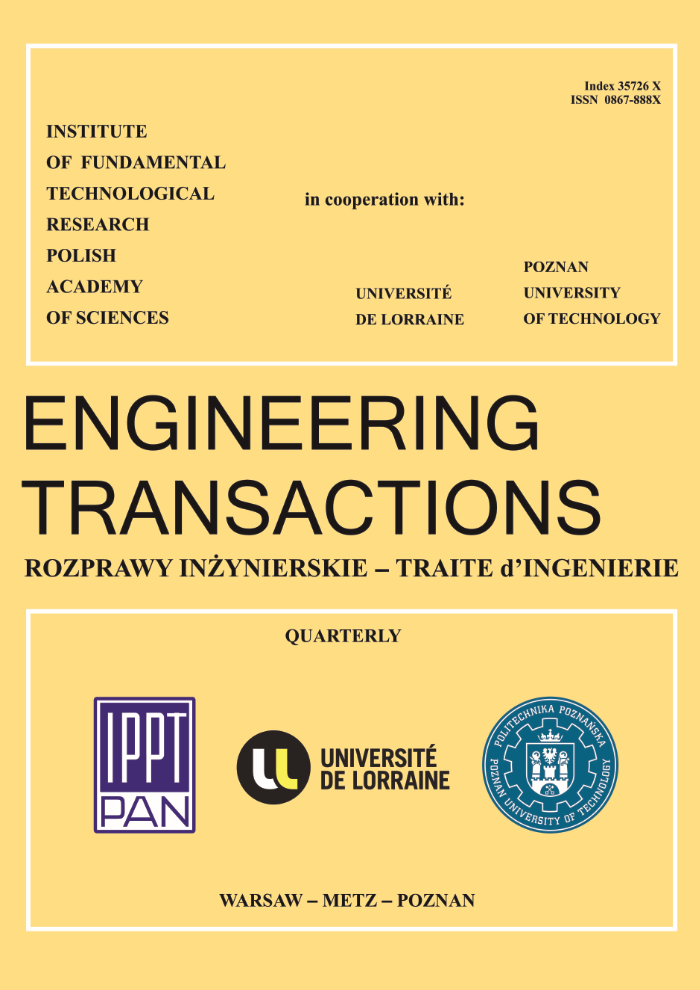Analysis of the Cutting Parameters Influence During Machining Aluminium Alloy A2024-T351 with Uncoated Carbide Inserts
Abstract
This work aims to analyze the effect of the cutting parameters on chip segmentation of the aluminium alloy A2024-T351 during machining process. In this work, two parameters are considered: the tool rake angle of the cutting tool and the feed under dry machining. An orthogonal cutting FE model is developed in Abaqus/Explicit for this purpose. A thermo-visco- plastic-damage model for the machined material and thermo-rigid behaviour for the cutting tool have been assumed. At the chip/tool contact zone, the modified Coulomb friction model has been adopted. Thermal effects are considered by taking into account the heat flux generated by visco-plastic strain and also by friction at the tool-workpiece interface. The obtained results showed the effect of the tool rake angle and feed on the cutting force and chip morphology as well as temperature distribution at the tool rake face.Keywords:
orthogonal cutting, tool rake angle, feed, FE analysis, cutting force, chip segmentationReferences
1. ABAQUS Documentation for version 6.8. Dassault Systems Simulia, 2008.
2. Johnson G.R., Cook W.H., Fracture characteristics of three metals subjected to various strains, strain rates, temperatures and pressures, Engineering Fracture Mechanics, 21, 31–48, 1985.
3. Li K., Gao X.-L., Sutherland J.W., Finite element simulations of the orthogonal metal cutting process for qualitative understanding of the effects of crater wear on the chip formation process, Journal of Materials Processing Technology, 127, 309–324, 2002.
4. Limido J., Espinosa C., Sala¨un M., Lacome J.L., SPH method applied to high speed cutting modelling, International Journal of Mechanical Sciences, 49, 898-908, 2007.
5. List G., Nouari M., G´ehin D., Gomez S., Manaud J.P., Le Petitcoprs Y., Girot F., Wear behaviour of cemented carbide tools dry machining of aluminium alloy, Wear, 259, 1177–1189, 2005.
6. Mebrouki T., Girardin F., Asad M., Rigal J-F., Numerical and experimental study of dry cutting for an aeronautic aluminium alloy (A2024-T351), International Journal of Machine Tools and Manufacture, 48, 1187–1197, 2008.
7. Molinari A., Moufki A., The Merchant’s model of orthogonal cutting revisited: A new insight into the modelling of chip formation, International Journal of Mechanical Sciences, 50, 124–131, 2008.
8. Ozlu E., Budak E., Molinari A., Analytical and experimental investigation of rake contact and friction behaviour in metal cutting, International Journal of Machine Tools and Manufacture, 49, 865–875, 2009.
2. Johnson G.R., Cook W.H., Fracture characteristics of three metals subjected to various strains, strain rates, temperatures and pressures, Engineering Fracture Mechanics, 21, 31–48, 1985.
3. Li K., Gao X.-L., Sutherland J.W., Finite element simulations of the orthogonal metal cutting process for qualitative understanding of the effects of crater wear on the chip formation process, Journal of Materials Processing Technology, 127, 309–324, 2002.
4. Limido J., Espinosa C., Sala¨un M., Lacome J.L., SPH method applied to high speed cutting modelling, International Journal of Mechanical Sciences, 49, 898-908, 2007.
5. List G., Nouari M., G´ehin D., Gomez S., Manaud J.P., Le Petitcoprs Y., Girot F., Wear behaviour of cemented carbide tools dry machining of aluminium alloy, Wear, 259, 1177–1189, 2005.
6. Mebrouki T., Girardin F., Asad M., Rigal J-F., Numerical and experimental study of dry cutting for an aeronautic aluminium alloy (A2024-T351), International Journal of Machine Tools and Manufacture, 48, 1187–1197, 2008.
7. Molinari A., Moufki A., The Merchant’s model of orthogonal cutting revisited: A new insight into the modelling of chip formation, International Journal of Mechanical Sciences, 50, 124–131, 2008.
8. Ozlu E., Budak E., Molinari A., Analytical and experimental investigation of rake contact and friction behaviour in metal cutting, International Journal of Machine Tools and Manufacture, 49, 865–875, 2009.






